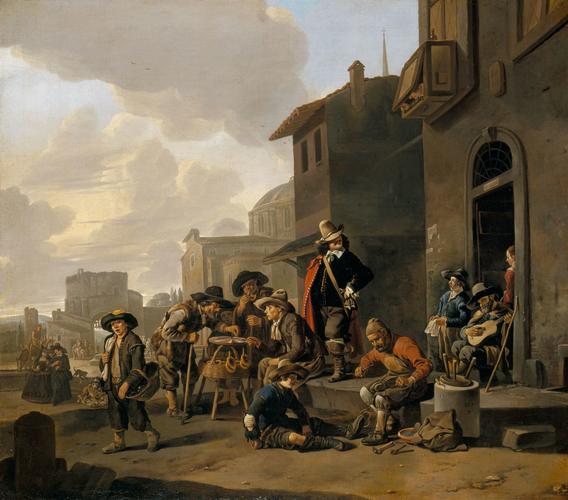-
1 of 253523 objects
Figures before a Locanda, with a View of the Piazza del Popolo, Rome c.1645-50
Oil on canvas | 63.2 x 72.6 cm (support, canvas/panel/stretcher external) | RCIN 404534
-
This is a classic Bamboccianti scene depicting Romans at their least prepossessing. During his first years in Rome Lingelbach lodged in this very street; had he chosen the locanda (hostel) depicted here, with its cheap paper windows and extraordinary projecting hatch, he would have had to pick his way through a variety of street traders: a ciambella (ring-shaped cake) seller, who also runs a girella (a species of roulette wheel banned in Rome at the time) and an old man mending a boy’s shoe while its owner sits in the dirt. Even the hostel door is barred by a blind musician playing a guitar while a boy sings and a suspicious young woman loiters. The armed man with his hat drawn over his eyes is even more sinister; he is certainly no mountebank, as has been suggested. Some context may be provided for this menacing presence and the couple in Spanish dress in the background by accounts of clashes between armed retainers of the kind which took place in 1646, at exactly the time Lingelbach was in Rome. Could this man be a retainer, the ‘hired gun’ of Baroque Rome?
The setting here can be recognised from contemporary topographical sketches, and shows a road, square, walls and gate, all of which date from Roman times. As in views of the Forum, we meditate upon the contrast of former glory and present ignominy, except that during the Renaissance and Baroque periods (1500–1700), successive popes turned the Piazza del Popolo into one of Europe’s most spectacular urban spaces. Lingelbach does not seem anxious to celebrate this achievement: he omits Sixtus V’s obelisk and shows the Roman Via Paolina obstructed by a stone platform and street vendors. The urban planning of Rome was policed by a functionary ascribed to each parish (rione) called the ‘Master of the Streets’ (Magister viarum); this image depicts everything that he sought to eliminate.
Falsely signed lower right: KDJProvenance
Purchased for George IV by Lord Yarmouth in 1811; recorded in the Middle Room upper floor at Carlton House in 1819 (no 160); in the Picture Gallery at Buckingham Palace in 1841 (no 163)
-
Creator(s)
Previously attributed to (artist)Acquirer(s)
-
Medium and techniques
Oil on canvas
Measurements
63.2 x 72.6 cm (support, canvas/panel/stretcher external)
85.0 x 94.4 x 5.5 cm (frame, external)
Category
Object type(s)
Other number(s)
Alternative title(s)
A mountebank and other figures before a locanda with a capriccio view of the Piazza del Popolo, Rome
